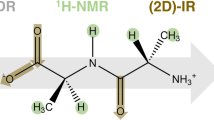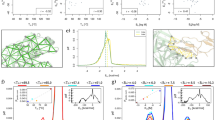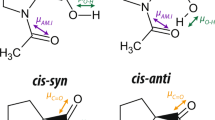Abstract
THE standard view of a helix formation in water, based on helix propensities determined by the host–guest method1,2, is that differences in helix propensity among the amino acids are small, except for proline3, and that the average value of the helix propaga-tion parameter s is near 1. A contradictory view of α helix formation in water is emerging from substitution experiments with short, unique-sequence peptides that contain only naturally occurring amino acids4–9. Short peptides that contain only alanine and lysine, or alanine and glutamate, form surprisingly stable monomeric helices in water9 and substitution of a single alanine residue by another amino acid in these or related peptides produces a wide range of changes in helix content, depending on which amino acid is substituted for alanine4–6,8. We show here that the ratio of the helix propensities of alanine to glycine is large, about 100, in substitution experiments with a 17-residue reference peptide containing alanine and lysine. The helix propensity is identified with s, the helix propagation parameter of the statistical mechanics model for α helix formation, and the results are interpreted by the Lifson–Roig theory10. Single alanine → glycine substitutions have been made at a series of positions in individual peptides. The helix-destabilizing effect of an Ala → Gly substitution depends strongly on its position in the helix, as predicted by the Lifson–Roig theory if the ratio of s values for Ala: Gly is large.
This is a preview of subscription content, access via your institution
Access options
Subscribe to this journal
Receive 51 print issues and online access
$199.00 per year
only $3.90 per issue
Buy this article
- Purchase on Springer Link
- Instant access to full article PDF
Prices may be subject to local taxes which are calculated during checkout
Similar content being viewed by others
References
Sueki, M. et al. Macromolecules 17, 148–155 (1984).
Scheraga, H. A. Proc. natn. Acad. Sci. U.S.A. 82, 5585–5587 (1985).
Altmann, K.-H., Wójcik, J., Vasquez, M. & Scheraga, H. A. Biopolymers 30, 107–120 (1990).
Padmanabhan, S., Marqusee, S., Ridgeway, T., Laue, T. M. & Baldwin, R. L. Nature 344, 268–270 (1990).
Merutka, G., Lipton, W., Shalongo, W., Park, S.-H. & Stelllwagen, E. Biochemistry 29, 7511–7515 (1990).
Lyu, P. C., Liff, M. I., Marky, L. A. & Kallenbach, N. R. Science 250, 669–673 (1990).
Strehlow, K. G. & Baldwin, R. L. Biochemistry 28, 2130–2133 (1989).
O'Neil, K. T. & DeGrado, W. F. Science 250, 646–651 (1990).
Marqusee, S., Robbins, V. H. & Baldwin, R. L. Proc. natn. Acad. Sci. U.S.A. 86, 5286–5290 (1989).
Lifson, S. & Roig, A. J.chem. Phys. 34, 1963–1974 (1961).
Zimm, B. H. & Bragg, J. K. J. chem. Phys. 31, 526–535 (1959).
Lotan, N., Yaron, A. & Berger, A. Bipolymers 4, 365–368 (1966).
Shoemaker, K. R., Kim, P. S., York, E. J., Stewart, J. M. & Baldwin, R. L. Nature 326, 563–567 (1987).
Creighton, T. E. Proteins 162–170 (Freeman, New York, 1983).
Brant, D. A., Miller, W. G. & Flory, P. J. molec. Biol. 23, 47–65 (1967).
Gō, M., Gō, N. & Scheraga, H. A. J. chem. Phys. 54, 4489–4503 (1971).
Houghten, R. A., DeGraw, S. T., Bray, M. K., Hoffman, S. R. & Frizzell, N. D. Biotechniques 4, 522–528 (1986).
Cantor, C. R. & Schimmel, P. R. Biophysical Chemistry Vol. III (Freeman, New York, 1980).
Poland, D. & Scheraga, H. A. Theory of Helix-Coil Transitions in Biopolymers (Academic, New York, 1970).
Chen, Y.-H., Yang, J.-T. & Chau, K. H. Biochemistry 13, 3350–3359 (1974).
Author information
Authors and Affiliations
Rights and permissions
About this article
Cite this article
Chakrabartty, A., Schellman, J. & Baldwin, R. Large differences in the helix propensities of alanine and glycine. Nature 351, 586–588 (1991). https://doi.org/10.1038/351586a0
Received:
Accepted:
Issue Date:
DOI: https://doi.org/10.1038/351586a0
This article is cited by
-
Structural resolution of switchable states of a de novo peptide assembly
Nature Communications (2021)
-
Biological Effects of Single-Nucleotide Polymorphisms in the Drosophila melanogaster Malic Enzyme Locus
Biochemical Genetics (2020)
-
Natural variations in OsγTMT contribute to diversity of the α-tocopherol content in rice
Molecular Genetics and Genomics (2015)
-
Consistent mutational paths predict eukaryotic thermostability
BMC Evolutionary Biology (2013)
-
A Combination of Structural and Cis-Regulatory Factors Drives Biochemical Differences in Drosophila melanogaster Malic Enzyme
Biochemical Genetics (2012)
Comments
By submitting a comment you agree to abide by our Terms and Community Guidelines. If you find something abusive or that does not comply with our terms or guidelines please flag it as inappropriate.



